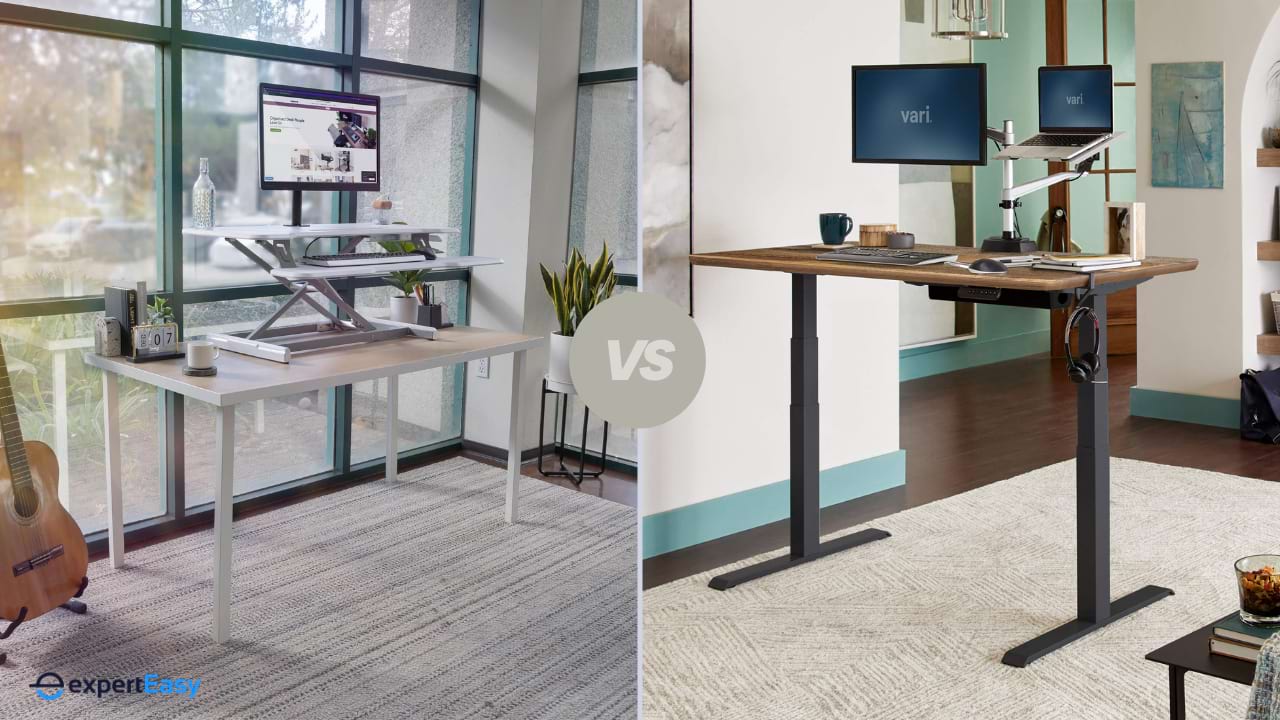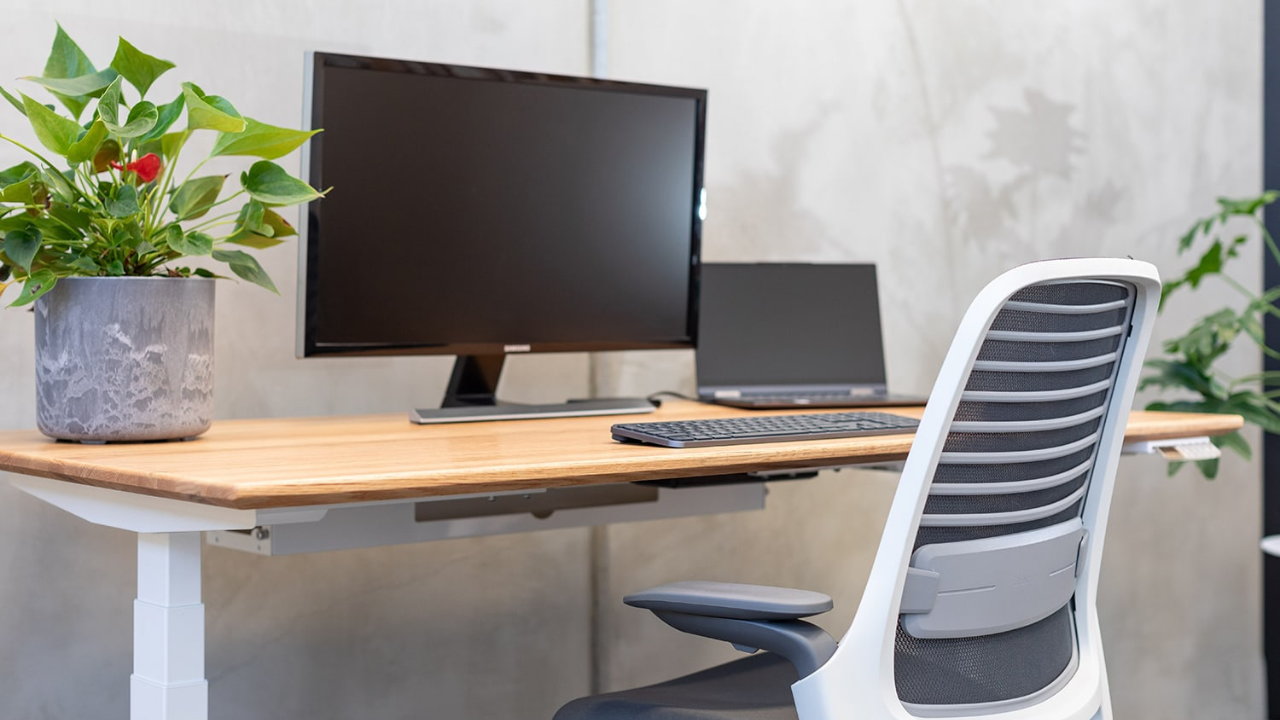Office furniture is crucial to your productivity, well-being, and overall health. So, you must take time to do the appropriate research on which desk and chair type best suits your needs. Sometimes, what is an ideal setup for a friend or work colleague might prove otherwise for you.
One such decision is choosing between a full sit-stand desk or a standing desk converter that works with your current desk. In this blog, I share my insights and experiences to help you decide.
What is a Desk Converter?

A standing desk converter sits on top of your regular desk, allowing you to switch between sitting and standing. It's like a mini desk that can be adjusted up or down, allowing you to change your position.
Desk converters are a convenient and cost-effective way to make your workspace more flexible and comfortable. You don't have to buy a new desk to enjoy the benefits of standing while working. There are also several types, each with its unique features. Here are the common ones:
- Z-lift and X-lift converters: These have a Z-shaped or X-shaped scissor lift mechanism to lift and lower the desk surface.
- Post & base converters: They are compact and space-efficient converters with a single post in the middle and a platform on top.
- Electric converters: Powered by a motor and adjustable through a button or control panel, electric converters offer a hassle-free use experience.
Each type has advantages and potential downsides, so it’s about finding which suits your needs and workspace. Compared to standing desks, desk converters are the more affordable pick.
What is a Standing Desk?

A standing desk is any desk that lets you stand while working. They are often adjustable to different heights, help you stay more active, and reduce the strain from sitting for long periods. Like sit-stand desk converters, there are three types of standing desks. These include:
- Manual Standing Desks that require you to adjust the height by hand, usually by turning a crank.
- Electric Standing Desks that have a motor that raises and lowers the desk at the push of a button.
- Fixed Standing Desks that are set at a standing height and don't adjust.
Many standing desks have memory settings to save your preferred heights. Others include programmable features like reminders to stand or sit, which keep you active and help you maintain good posture throughout the day.
Full-fledged standing desks offer more features and functionalities than desk converters. Thus, they are my recommended pick if you want more from your sit-stand desk. However, they require a hefty investment.

Standing Desks vs. Desk Converters: Comparisons
For most people, the budget-friendly vs feature-rich difference is enough to make a decision. But if you need an in-depth comparison between the two to decide, here are some comparisons to make an informed decision:
#1 - Space and flexibility
Do you have enough space? Standing desks require more space and a complete change of furniture. While they offer a seamless transition to using standing desks, they need enough room to accommodate the desk's footprint.
On the other hand, desk converters sit on top of your existing desk, making them ideal for smaller spaces or if I want to keep your current desk. They provide flexibility without a significant overhaul of your workspace.
#2 - Ergonomics
Also important is ergonomics. What use is office furniture if it doesn’t improve your comfort or productivity level? Standing desks, especially electric sit-stand desks, allow for precise height adjustments to achieve optimal ergonomic positioning for sitting and standing.
While sit-stand desk converters also provide ergonomic benefits, they often have height adjustment range and keyboard placement limitations, which could affect posture. Similarly, most desk converters require manual adjustment, which varies in ease of use depending on the desk type.
#3 - Stability and weight capacity
Standing desks are generally more stable and handle heavier loads, especially dual motor models. They are ideal for multiple monitors and other heavy equipment. Honestly, if you use more than one monitor concurrently or combine many accessories while working, choose a standing desk.
You'll find high-quality desk converters that are stable enough and can support multiple monitors concurrently, but the cheaper models often wobble or have lower weight limits. I only recommend them if you work with a laptop or lightweight tools to maintain their stability.
#4 - Long-term investment
Standing desks are a long-term investment in your health and productivity. They are more durable and offer better features for extended use. They also come with extended warranties that span to 15 years.
On the other hand, while they can be long-term solutions, desk converters are a good starting point for trying out a standing workspace without a significant financial commitment. Once satisfied with their functionality, you can confidently invest in a high-end sit-stand desk.

FAQs
Is it OK to use a standing desk all day?
While standing desks help reduce the health risks associated with sitting too much, standing for long can cause leg pain, fatigue, and lower back issues. It's best to alternate between sitting and standing throughout the day to give your body a break and maintain good posture. Aim for a balance that works for you, such as standing for 30-60 minutes every couple of hours, to stay comfortable and healthy.
Do electric desks use a lot of electricity?
No, electric desks don't use a lot of electricity. They only consume power when adjusting the height, which usually takes a few seconds. The amount of electricity used during these adjustments is minimal, so you won't see a significant increase in your electricity bill.
How long should you sit at a standing desk?
I recommend sitting for about 20-30 minutes and standing for 5-10 minutes. This reduces strain on your body and keeps you comfortable. The key is to find a balance that works for you so you stay active and avoid the adverse effects of both prolonged sitting and standing.

Summary
We've discussed the differences between standing desks and desk converters, including cost, space requirements, stability, ergonomics, and long-term investment potential.
To summarise, a standing desk is better if you want a long-term solution and are willing to invest more. On the other hand, a desk converter is a more affordable, flexible, and space-saving option.
Both options have pros and cons, so consider your needs, budget, and workspace constraints. Regardless of your choice, I recommend alternating between sitting and standing to maintain a good balance.








